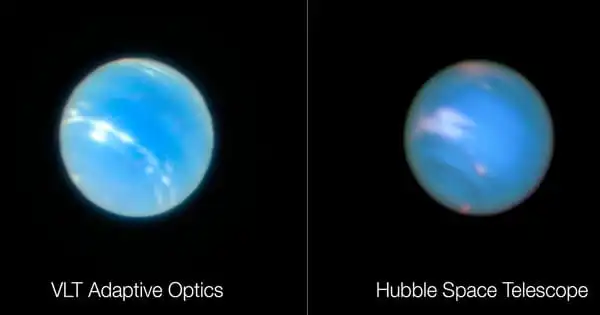Neptune is the most distant planet in our solar system, the eighth major planet from the Sun. The ice giant is more than 30 times the distance from the Sun as Earth. It is dark, cold, and whipped by supersonic winds. Neptune lacks a solid surface. Its atmosphere is mostly hydrogen, helium, and methane, and it extends to great depths before gradually merging into water and other melted ices, enclosing a solid core about the same mass as Earth.
Neptune’s atmospheric temperature is on an unexpected roller-coaster ride, and scientists may need decades to piece together what’s going on at the distant planet.
Researchers from NASA and other organizations examined ground-based images of Neptune taken in the mid-infrared range between 2003 and 2020. The images show that between 2003 and 2009, Neptune’s stratosphere appeared to cool, followed by a dramatic warming of the south pole between 2018 and 2020. Upper-tropospheric temperatures, on the other hand, did not vary much, with the exception of the south pole, which appeared to be the warmest between 2003 and 2006.
We weren’t expecting any seasonal changes to occur in such a short time period because we haven’t even seen a full season. Everything is strange and interesting. Seasons on Neptune are expected to change slowly because the planet takes 165 years to orbit the Sun.
Rowe-Gurney
Seasons on Neptune are expected to change slowly because the planet takes 165 years to orbit the Sun. Researchers report in Planetary Sciences Journal that the ice giant’s global temperature dropped by about 8 degrees Celsius between 2003 and 2012, at the start of Neptune’s summer. Then, between 2018 and 2020, thermal images show that the planet’s south pole brightened dramatically, indicating an 11-degree Celsius increase.
Naomi Rowe-Gurney, a planetary scientist at NASA Goddard Space Flight Center in Greenbelt, Md., and colleagues examined 17 years of mid-infrared data from ground-based telescopes and the now-defunct Spitzer Space Telescope. The researchers used infrared light to peer through Neptune’s top cloud layer and into its stratosphere, where the planet’s atmospheric chemistry is visible.
Each Neptune year lasts 165 Earth years, so the time period studied — from 2003 to 2020 — is roughly equivalent to five weeks on Earth. The most extreme temperature shift occurred between 2018 and 2020, when the atmospheric temperature at Neptune’s south pole rose from –121° C to –110° C.

“We weren’t expecting any seasonal changes to occur in such a short time period because we haven’t even seen a full season,” Rowe-Gurney says. “Everything is strange and interesting.”
The thick atmosphere of Neptune is mostly hydrogen, with traces of helium and methane. Neptune’s deep blue color is due to the absorption of red light by methane. The average temperature on Neptune is a freezing -373 degrees Fahrenheit. At -391 degrees Fahrenheit, Triton, Neptune’s largest satellite, has the coldest temperature measured in our solar system. That is only 68 degrees Fahrenheit above absolute zero, the point at which all molecular action ceases.
The researchers are still unsure of what is causing the temperature changes. Because ultraviolet rays from the sun break down methane molecules in the stratosphere, chemistry or even the sun’s activity cycle could be a trigger. More observations are required to nail down specifics. “We need to keep observing for the next 20 years to see if anything else changes,” Rowe-Gurney says.
Neptune has the most bizarre and unusual weather in the entire Solar System. It experiences massive storms with extremely high winds. Its atmosphere has dark spots that appear and disappear, as well as bright cirrus-like clouds that change rapidly. Neptune’s average temperature is -353 degrees Fahrenheit (-214 Celsius). On Earth sunlight drives our weather, but Neptune is so far away that it receives a thousand times less sunlight than Earth does. How Neptune gets the energy for such intense weather is still a mystery.
















